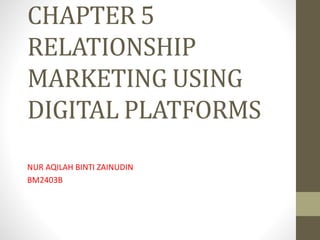This document discusses using digital platforms for customer relationship management. It defines key concepts like customer relationship management (CRM), one-to-one marketing, and electronic CRM (E-CRM). E-CRM uses digital technologies to maximize sales to existing customers, while social CRM manages customer-to-customer conversations to engage customers, prospects, and other stakeholders. The document also examines techniques for customer engagement, acquisition, retention, and extension using digital media and discusses how to measure customer satisfaction and loyalty online.




























